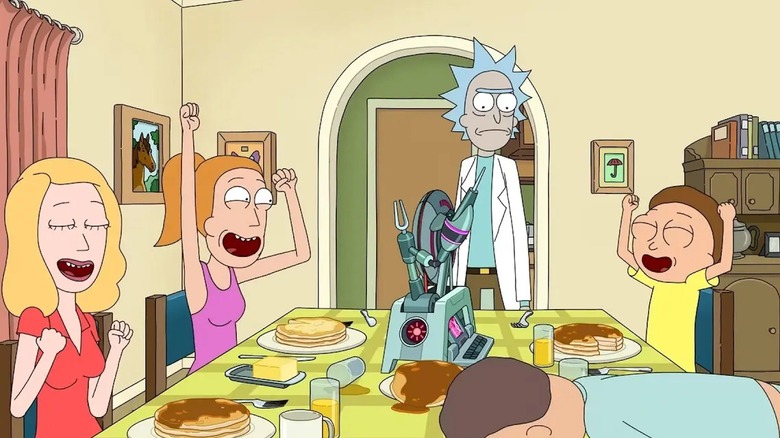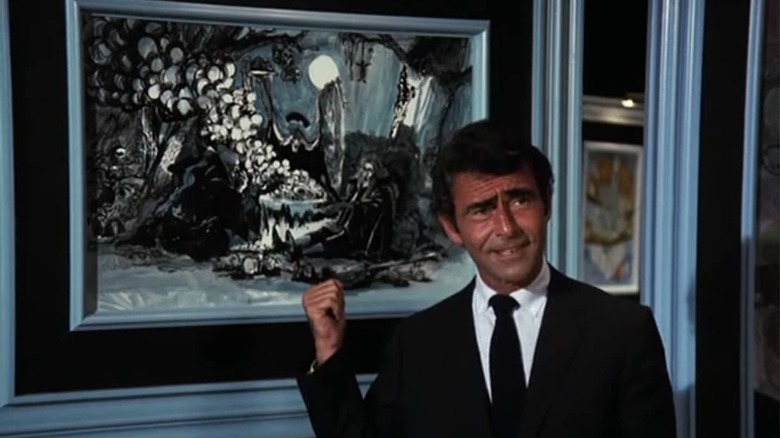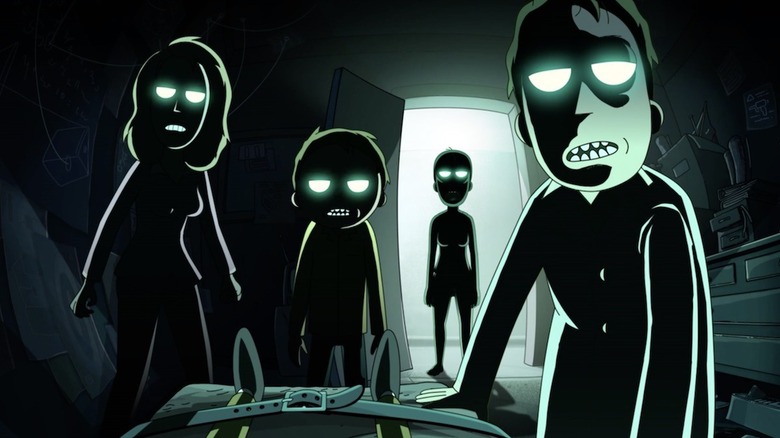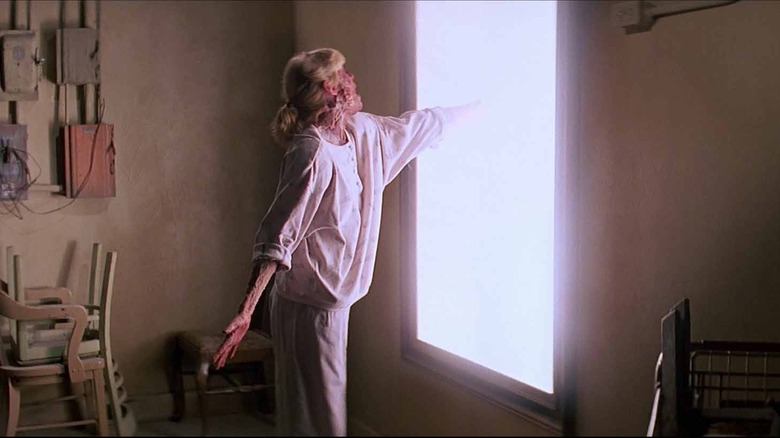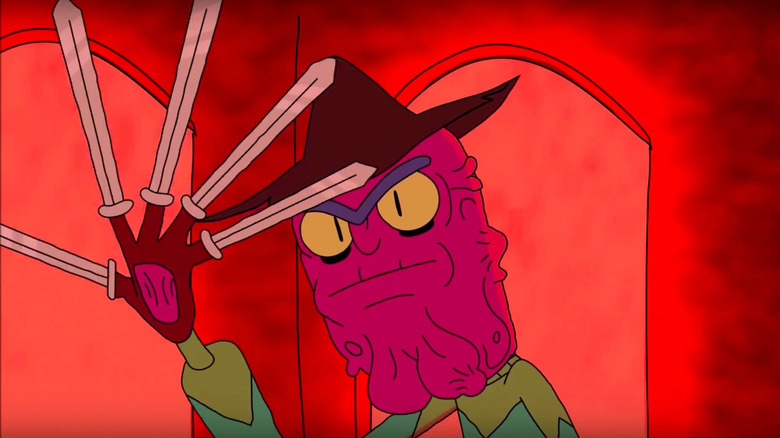Rick And Morty Season 6 Features Some Brilliant References To Horror Filmmaker John Carpenter
"Rick and Morty" is a series that's suffused with references to numerous films, TV shows, books, and other forms of pop culture. After all, the show itself began life as co-creator Justin Roiland's skewed riff on "Back to the Future," and co-creator Dan Harmon's previous series as showrunner, "Community," was continually pushing the envelope when it came to parodying and homaging films.
Yet the fact that "Rick and Morty" is now in its sixth season means that the show has to keep digging deeper for homages and references that not only haven't been done to death, but that the series itself hasn't attempted yet. Despite the show's science fiction premise, "Rick and Morty" is no stranger to horror, with episodes like season 1's "Rick Potion No. 9," season 2's "Total Rickall" and season 4's "Promortyus" all riffing on horror creatures and tropes.
Yet those episodes involve sci-fi/horror concepts, and so far the series hasn't delved too deeply into the realm of supernatural horror (save a Scary Terry or two). That's all changed with the latest episode of Season 6, "Night Family," which includes a bevy of clever, subtle references to supernatural horror films, especially those made by legendary director John Carpenter.
Are you afraid of the night?
Before we even get to the overt John Carpenter references, "Night Family" announces its intentions right from the beginning, starting with its title. While "Rick and Morty" episodes typically have titles that insert the names of their characters into a movie title ("Close Rick-counters of the Rick Kind," "The Ricks Must Be Crazy," "The Rickchurian Mortydate," etc.), the title is sometimes a flat-out parody regarding the episode itself (as in "The Old Man and the Seat" and "Look Who's Purging Now").
The title "Night Family" is not only one of the latter, but is a sly riff on the proliferation of the word "night" in so many titles of horror media. The title may be a homophonic reference to "Night Gallery," the 1970-1973 horror TV anthology created and hosted by Rod Serling. Yet it also belongs to the grand tradition of "night" titles, including but not limited to: "Night Creatures," "Night School," "Night Terrors," "Night of the Comet," "Night of the Demons," "Nightbreed," and of course, "Night of the Living Dead."
Night Family looks into The Fog
In the episode, the Smith family discover that Rick has been using a device called the Somnambulator that allows him to create a "night person" for himself, which is essentially a persona that takes over his body while his conscious mind sleeps. Given that night people can be made to accomplish tasks that the Smiths either have always wanted to do or just hate doing while awake, Rick agrees to let everyone in the family have a night person. Sure enough, things start to go wrong when Night Summer becomes irked by the Day People not rinsing their dirty dishes before putting them in the sink.
The episode's depiction of the Night Smiths references a common horror trope in one major scene: we see the family backlit while their eyes radiate an eerie glow. While this look turns up in a number of horror films (Lamberto Bava's "Demons," for one), it's likely that writer Rob Schrab and directors Wesley Archer, Johnny Tesoro and Jacob Hair had John Carpenter's "The Fog" in mind. In that film, the ghostly apparitions that haunt the Northern California town of Antonio Bay are frequently seen in atmospheric, shadowy backlight. The chief ghost, Blake (played by the film's makeup designer, Rob Bottin), has glowing red eyes, a similar look to the Night Smiths.
That said, given the scene's color palette in the episode, it's also possible the look was inspired by the trope of glowing green eyes in horror, as seen in such films like "Mausoleum" and "Retribution." Either way, it's a fantastically spooky look.
Rick and Morty meet the Prince of Darkness
While the Night Family's glowing eyes could be referencing a number of sources, there's no doubt that Carpenter was most present in Schrab's mind when writing "Night Family." According to co-creator Harmon, Schrab "had a real vision for that episode being like a John Carpenter movie."
While the visual aesthetic of "The Fog" and the general vibes of Carpenter's work pervade the episode (especially its synth-heavy score), the biggest reference to a single Carpenter film in "Night Family" is 1987's "Prince of Darkness." In the episode, it's revealed that the Night Smiths have secretly constructed a much larger version of the Somnambulator in the basement of the Smith home, with Night Rick, Night Jerry, Night Beth, and Night Morty in thrall to Night Summer's commands.
This is highly akin to the events of "Prince of Darkness," which features a group of scientists and researchers discovering a cylinder in the basement of an old church that contains a roiling green substance, which possesses the scientists one by one. Soon the scientists are in thrall to the substance (which is Satan in liquid form), and take their orders from the possessed woman, Kelly (Susan Blanchard), who has become Satan's avatar.
Not only does Kelly have a very Summer-esque look (ponytail and all), but in possessed form she speaks in a throaty, scratchy whisper — the same way Night Summer and the rest of the Night Smiths talk. The episode's dark ending, which sees the Night Smiths winning the war between themselves and the Day Smiths (that is, until they become disenchanted with the responsibilities of life and decide to destroy the Somnambulator), is also a reference to "Prince of Darkness" and its downbeat climax. Carpenter didn't dub the film part of his "Apocalypse Trilogy" for nothing!
A little slice of Scary Terry
"Night Family" ventures beyond Carpenter references to pay homage to a number of other horror films. The premise of doppelgängers taking over the Smith's lives strongly recalls the "Invasion of the Body Snatchers" films and more recent work like Jordan Peele's "Us," while the Night Family's name for the Day Smiths, "Daymonoids," may be a reference to the 1981 Mexican horror film "Demonoid."
There's one reference, however, which may harken back to Scary Terry from season 1's "Lawnmower Dog." Scary Terry was, of course, a parody of Freddy Krueger from the "Nightmare on Elm Street" franchise, and while films beginning with a title card quoting from some literary source can be found in numerous movies, horror or not, the "Nightmare" series made a tradition out of it. "A Nightmare on Elm Street 3: Dream Warriors," "A Nightmare on Elm Street 4: The Dream Master," and "Freddy's Dead: The Final Nightmare" all feature quotations prior to their opening scenes (from Edgar Allan Poe, the Book of Job, and Friedrich Nietzsche, respectively).
"Night Family" begins with a title card that strongly recalls the "Elm Street" trend, featuring a quotation from poet T.S. Eliot. The quote is taken from Eliot's "Sweeney Agonistes," specifically the scene entitled "Fragment of an Agon." Not only is the quote thematically appropriate, but it's just pretentious enough to recall the "Elm Street" openings, and certainly silly-sounding enough for "Rick and Morty."
With "Night Family" and "Rick: A Mort Well Lived" making homages and references to films so deftly and intelligently, one can't help but be excited to see what the rest of season 6 holds. It's a good thing the Night Smiths have decided to allow the Day Smiths to continue to have further adventures ... or have they?
